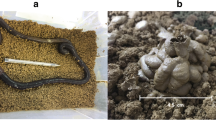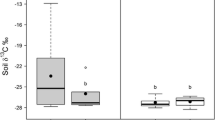Abstract
Purpose
Endogeic earthworms play a significant role in biogeochemical cycles due to the large amount of soil they ingest, and because after transit through their guts, casts usually show differences in nutrient contents and microbial populations with bulk soil. Here, we studied how three endogeic earthworm species, Postandrilus majorcanus, Postandrilus sapkarevi and Postandrilus palmensis, inhabiting soils in Majorca island (Balearic Islands, W Mediterranean), modify nutrient pools and microbial communities of soil.
Materials and methods
To do this, we analysed C, N and P pools, microbial biomass (phospholipid fatty acids, PLFA) and microbial activity (fluorescein diacetate hydrolysis, FDA) in paired samples of bulk soil and fresh casts.
Results and discussion
The mineral and organic N contents were generally enhanced in casts produced by all three earthworm species. However, inorganic P and organic C contents were only higher in P. sapkarevi (32 %, only P) and P. majorcanus casts (100 % for both soil nutrient pools) than in bulk soil. Bacterial and fungal biomass were only higher than in bulk soil in P. majorcanus casts (65 and 100 %, respectively), but without effects on microbial activity, that was lower in P. palmensis casts (26 %). Earthworm gut transit strongly influenced the soil microbial community structure, resulting in differences between casts and soils.
Conclusions
The increased nutrient mineralization (6-, 1.3- and 1.4-fold for N, C and P, respectively) in casts produced by these earthworm species is of particular importance because of the amount of casts released and the seasonal variations in earthworm activity, which may favour plant growth.

Similar content being viewed by others
References
Adam G, Duncan H (2001) Development of a sensitive and rapid method for the measurement of total microbial activity using fluorescein diacetate (FDA) next term in a range of soils. Soil Biol Biochem 33:943–951
Aira M, Monroy F, Domínguez J (2003) Effects of two species of earthworms (Allolobophora spp.) on soil systems: a microfaunal and biochemical analysis. Pedobiologia 47:877–881
Aira M, Monroy F, Domínguez J (2005) Ageing effects on nitrogen dynamics and enzyme activities in casts of Aporrectodea caliginosa (Lumbricidae). Pedobiologia 49:467–473
Aira M, Lazcano C, Gómez-Brandón M, Domínguez J (2010) Ageing effects of casts of Aporrectodea caliginosa on soil microbial community structure and activity. Appl Soil Ecol 46:143–146
Allen SE, Grimshaw HM, Rowland AP (1986) Chemical analysis. In: Moore PD, Chapman SB (eds) Methods in plant ecology. Blackwell Scientific, Oxford, pp 285–344
Bååth E (2003) The use of neutral lipid fatty acids to indicate the physiological conditions of soil fungi. Microb Ecol 45:373–383
Bisht R, Pandey H, Bisht SPS, Kandpal B, Kaushal BR (2006) Feeding and casting activities of the earthworm (Octolasion tyrtaeum) and their effects on crop growth under laboratory conditions. Trop Ecol 47:291–294
Brown GG, Doube BM (2004) Functional interactions between earthworms, microorganisms, organic matter and plants. In: Edwards CA (ed) Earthworm ecology. CRC Press, Boca Raton, pp 213–240
Brown GG, Barois I, Lavelle P (2000) Regulation of soil organic matter dynamics and microbial activity in the drilosphere and the role of interactions with other edaphic functional domains. Eur J Soil Biol 36:177–198
Buck C, Langmaack M, Schrader S (1999) Nutrient content of earthworm casts influenced by different mulch types. Eur J Soil Biol 35:23–30
Cabrera ML, Beare MH (1993) Alkaline persulfate oxidation for determining total nitrogen in microbial biomass extracts. Soil Sci Soc Am J 57:1007–1012
Chapuis-Lardy L, Brossard M, Lavelle P, Schouller E (1998) Phosphorus transformations in a ferralsol through ingestion by Pontoscolex corethrurus, a geophagous earthworm. Eur J Soil Biol 34:61–67
Chapuis-Lardy L, Ramiandrisoa RS, Randriamanantsoa L, Morel C, Rabeharisoa L, Blanchart E (2009) Modification of P availability by endogeic earthworms (Glossoscolecidae) in Ferralsols of the Malagasy Highlands. Biol Fertil Soils 45:415–422
Chapuis-Lardy L, Brauman A, Bernardb L, Pablo AL, Toucetb J, Mano MJ, Weber L, Brunet D, Razafimbelo T, Chotte JL, Blanchart E (2010) Effect of the endogeic earthworm Pontoscolex corethrurus on the microbial structure and activity related to CO2 and N2O fluxes from a tropical soil (Madagascar). Appl Soil Ecol 45:201–208
Domínguez J, Aira M, Gómez Brandón M (2010) Vermicomposting: earthworms enhance the work of microbes. In: Insam H, Franke-Whittle I, Goberna M (eds) Microbes at work: from wastes to resources. Springer, Berlin, pp 93–114
Dray S, Dufour AB (2007) The ade4 package: implementing the duality diagram for ecologists. J Stat Soft 22:1–20
Edwards CA (2004) Earthworm ecology. CRC Press, Boca Raton
Egert M, Marhan S, Wagner B, Scheu S, Friedrich MW (2004) Molecular profiling of 16S rRNA genes reveals diet-related differences of microbial communities in soil, gut, and casts of Lumbricus terrestris L. (Oligochaeta: Lumbricidae). FEMS Microbiol Ecol 48:187–197
Frostegård A, Bååth E (1996) The use of phospholipid analysis to estimate bacterial and fungal biomass in soils. Biol Fertil Soils 22:59–65
Gómez Brandón M, Lores M, Domínguez J (2010) A new combination of extraction and derivatization methods that reduces the complexity and preparation time in determining phospholipid fatty acids in solid environmental samples. Bioresour Technol 101:1348–1354
Horn MA, Schramm A, Drake HL (2003) The earthworm gut: an ideal habitat for ingested N2O-producing microorganisms. Appl Environ Microbiol 69:1662–1669
Jensen ES (1997) Nitrogen immobilization and mineralization during initial decomposition of 15N-labelled pea and barley residues. Biol Fertil Soils 24:39–44
Knapp BA, Podmirseg SM, Seeber J, Meyer E, Insam H (2009) Diet-related composition of the gut microbiota of Lumbricus rubellus as revealed by a molecular fingerprinting technique and cloning. Soil Biol Biochem 41:2299–2307
Lauber CL, Zhou N, Gordon JI, Knight R, Fierer N (2010) Effect of storage conditions on the assessment of bacterial community structure in soil and human associated-samples. FEMS Microbiol Lett 307:80–86
Lavelle P, Spain AV (2001) Soil ecology. Kluwer Scientific Publications, Amsterdam
Le Bayon RC, Binet F (2006) Earthworms change the distribution and availability of phosphorus in organic substrates. Soil Biol Biochem 38:235–246
Marhan S, Scheu S (2006) Mixing of different mineral soil layers by endogeic earthworms affects carbon and nitrogen mineralization. Biol Fertil Soils 42:308–314
Parkin TB, Berry EC (1994) Nitrogen transformations associated with earthworm cast. Soil Biol Biochem 26:1233–1238
Pérez-Losada M, Breinholt J, González-Porto P, Aira M, Domínguez J (2011) An earthworm riddle: systematics and phylogeography of the Spanish lumbricid Postandrilus. Plos ONE 6:e28153
Qiu J-P, Bouche MB (1998) La decouverte de Postandrilus ge. Nov. (Oligochaeta: Lumbricidae) et remarques sur la reproduction des lombriciens. Doc pedozoologiq integrologiq 4:65–72
R Development Core Team (2007) R: a language and environment for statistical computing. R Foundation for Statistical Computing, Vienna, Austria. ISBN 3-900051-07-0, URL http://www.R-project.org
Raw F (1959) Estimating earthworm populations by using formalin. Nature 184:1661–1662
Sims GK, Ellsworth TR, Mulvaney RL (1995) Microscale determination of inorganic nitrogen in water and soil extracts. Commun Soil Sci Plant Anal 26:303–316
Singleton DR, Hendrix PF, Coleman DC, Whitman WB (2003) Identification of uncultured bacteria tightly associated with the intestine of the earthworm Lumbricus rubellus (Lumbricidae; Oligochaeta). Soil Biol Biochem 35:1547–1555
Soil Atlas of Europe, European Soil Bureau Network European Commission (2005) 128 pp Office for Official Publications of the European Communities, L-2995 Luxembourg
Tate RL (2000) Soil microbiology. Wiley, New York
Thakuria D, Schmidt O, Finan D, Egan D, Doohan FM (2009) Gut wall bacteria of earthworms: a natural selection process. ISME J 4:357–366
Tiunov AV, Scheu S (2000a) Microfungal communities in soil, litter and casts of Lumbricus terrestris L. (Lumbricidae): a laboratory experiment. Appl Soil Ecol 14:17–26
Tiunov AV, Scheu S (2000b) Microbial biomass, biovolume and respiration in Lumbricus terrestris L. cast material of different age. Soil Biol Biochem 32:265–275
Zhang QL, Hendrix PF (1995) Earthworm (Lumbricus rubellus and Aporrectodea caliginosa) effects on carbon flux in soil. Soil Sci Soc Am J 59:816–823
Acknowledgments
This research was financially supported by the Spanish Ministerio de Ciencia e Innovación (CTM2009-08477) and the Xunta de Galicia (CN2012/305).
Author information
Authors and Affiliations
Corresponding author
Additional information
Responsible editor: Zucong Cai
Rights and permissions
About this article
Cite this article
Aira, M., Domínguez, J. Changes in nutrient pools, microbial biomass and microbial activity in soils after transit through the gut of three endogeic earthworm species of the genus Postandrilus Qui and Bouché, 1998. J Soils Sediments 14, 1335–1340 (2014). https://doi.org/10.1007/s11368-014-0889-1
Received:
Accepted:
Published:
Issue Date:
DOI: https://doi.org/10.1007/s11368-014-0889-1




